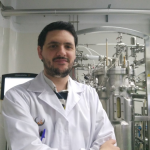- This topic has 14 replies, 8 voices, and was last updated 5 years, 5 months ago by
 Sabine Suppmann.
Sabine Suppmann.
-
AuthorPosts
-
-
July 2, 2020 at 09:16 #3067

Sabine SuppmannModeratorDear Colleagues
we increasingly purify secreted proteins from HEK2993 stable pools.
We are always struggling with the filtering process and need four to five 0.45µ bottle top. Any advice how to improve that ? (and make it a more sustainable procedure)
Thanks
Best
Sabine -
July 2, 2020 at 09:27 #3068

Jan-Erik HoffmannParticipantHi Sabine!
We use a reusable device that accepts round Whatman filter papers for this purpose. If you want I can send you a picture / part number.
Best regards,
Erik -
July 2, 2020 at 10:03 #3069

Nick BerrowModeratorHi Sabine,
Sounds like we do the same as Jan.
Re-usable 500ml filter support:
https://www.thermofisher.com/order/catalog/product/DS0320-2545#/Dwith any 47mm paper filter and the filtrate is normally clear enough for at least 2litres of media to easily pass low pressure columns HisTrap/StrepTrap etc. without any trouble.
Our support has lasted >10 years!
We also find the standard 0.22 or 0.45µm filters completely unusable with eukaryotic media especially when you are beginning to get cell death at the end of a 5 day transfection for secreted proteins.
Best
Nick -
July 2, 2020 at 10:03 #3070

Sabine SuppmannModeratorHi Jan-Erik
thanks !
We use a reusable device and whatman filters for buffer filtration, but the filters have the same cutoff 0.45µ? So you also need time, just not consume tons of plastic, correct?
The problem is when purifying endotoxin free, we need NaOH treatable materials and in this case prefer disposables
Best
Sabine -
July 2, 2020 at 10:04 #3071

Patrick DuriezParticipantDear Sabine,
I usually centrifuge my transient 293 transfections up to 4000 rpm for at least 30 min, then pipette out the supernatant carefully. I never pour the supernatant directly on the filter. This works easily for small-medium scale.
Kind regards,
Patrick -
July 2, 2020 at 10:08 #3072

Sabine SuppmannModeratorHi Jan-Erik and Nick and Patrick
we use exactly the same device for buffers. What filters ? Your really mean 47mm ?
And what if endotoxin free?
Pipetting out is not an option with 4-8 L. But I could also centrifuge higher I do 1800 for 20minBest
Sabine-
July 2, 2020 at 10:37 #3074

Nick BerrowModeratorWe use a standard 47mm diameter 3M paper filter in the holder .
I also forgot to say that this is after a low speed spin of ca 500g for 10 mins to remove most of the cells and another at 4000g for 10 minutes.
Sorry got a bit ahead of myself there…
Nick
-
-
July 2, 2020 at 10:25 #3073

Ra RomanParticipantHi Sabine
We’re currently using large scale autoclavable Opticap filters from millipore (KGEPG003HH3) prior to chromatography, they have smaller versions for lower volumes (We have them, but i dont remember the reference number). Also Sartorius can provide you with a range of solutions for one step filtration without using so many o,45 bottles (http://psfiltracion.com/psf/wp-content/uploads/2017/03/Data_Sartopore2-0.45_MidiCaps_SPK2061-e.pdf), but be careful, all filters need to be evaluated in a protein-to protein basis, we have some surprises with product retention with some molecules.
Besides,this kind of filters aren’t cheap, but they’re the industry standard and work very well and consistently.
Best,
Ramon
-
July 2, 2020 at 11:20 #3075

Ondrej VanekParticipantJan-Erik, post it also here, please…
We use 0.22 um PES bottle top filters, over the years we tried many vendors, good ones were from Millipore, Sigma and Corning – we regenerate them by washing with diluted bleach, like this they can be reused many many times, which makes the filtration a more sustainable step.
-
July 2, 2020 at 12:30 #3078

Ondrej VanekParticipantAnd yes, I forgot to mention, centrifuging at higher rpm / rcf helps a lot, we go for 10000 rpm, that makes the supernatant much clearer and filtration a lot easier. With our usual 400 ml per production flask we use 85 ml centrifugal tubes for a normal table-top centrifuge, for bigger scales we can spin up to 4 x 1 l in our new big centrifuge, at 10000 rcf.
-
-
July 2, 2020 at 11:35 #3076

Patrick DuriezParticipantHi Sabine,
Since the volume is large, I think longer centrifugation at 4000 rpm, maybe up to 1 hour and pouring carefully should definitively help.
I also have many endotoxin-sensitive projects and I try to use mainly single use plastic, or NaOH-treatable material as you said. -
July 2, 2020 at 12:23 #3077

Mikael AnderssonParticipantWe use the linked ones for our supernatants.
We do however either spin down the cells before at 200g for 20 min (smaller volumes of usually 1-4L) or just let it sediment for a few hours (usually ≥ 8L). As you likely also know the viability also severely affect how fast the filters clog, we generally harvest at 75-80% viability at the least, often more.Hope that was of some use for you.
https://scientificfilters.com/filtration-devices-capsule-filters-polycap-6715-3604
-
July 2, 2020 at 14:32 #3079
sandrine vadon le goffParticipantHi Sabine
We centrifuge our supernatants just after harvest at 200-500g to remove big debris, and then before purification at 10 000g; it is usually enough for us to remove any particles (we sometimes pour the supernatant trough a sterile gaze to be sure to retain the pellet if it doe not stick to the tube). But we don’t have to be carefull about endotoxins for our applications
-
July 2, 2020 at 14:36 #3080

Jan-Erik HoffmannParticipantWe use the same filter support that Nick mentioned. We combine it with 47 mm Whatman filters, either 0.2 µm (ME24, cat# 10401712) or 3 µm (ME29), depending on the column substrate we want to use afterwards. For the ME24 we need around 2 filters per liter, so it still takes time but produces less waste. The ME29 is much faster of course.
Before filtration we centrifuge our cell culture 5 min at 1500 g and then the supernatant a second time for 15 min at 5000 g.
We didn’t treat them with NaOH, so I’m not sure about their resistance to that. But the material is probably similar to that in disposable filter units. -
July 3, 2020 at 08:25 #3081

Sabine SuppmannModeratorDear All,
wow if this is not comprehensive ! Thank you all for your advice, very much apprechiated.
Next battle is on monday, 5 x 2L…….
Have a nice weekend
Sabine
-
-
AuthorPosts
You must be logged in to reply to this topic.
